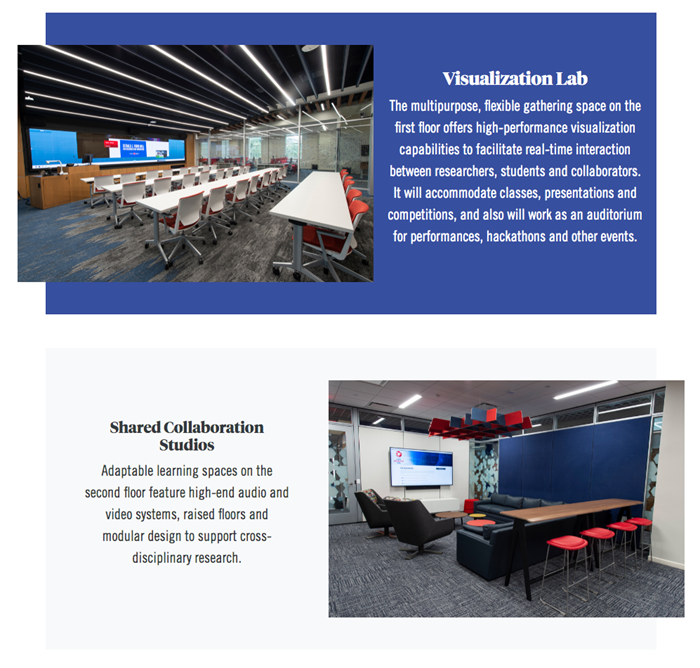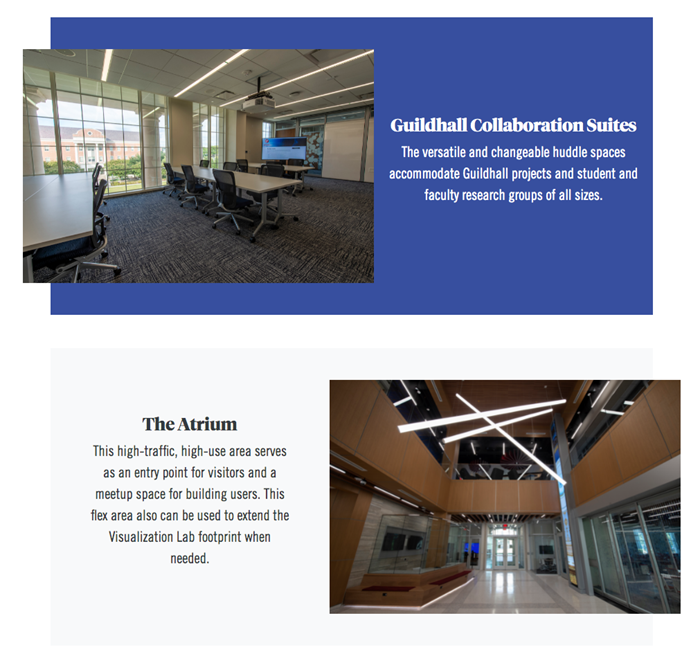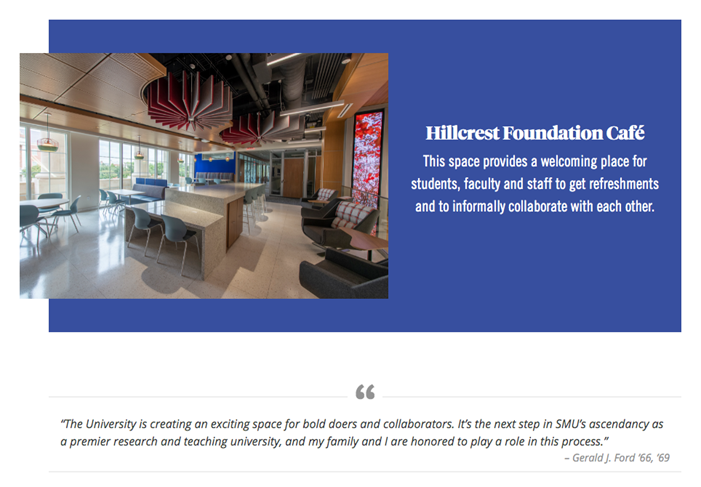A Simulated Game Studio Environment within Ford Hall
SMU Guildhall brings the functionality and flair of a video game studio to the academic landscape. Our classrooms offer high-tech design and function, and much of our building was modeled after real studio environments. Here you'll find:
Labs, Classrooms, and Studios
Inside Ford Hall, you'll find 33 research game labs and game studios dedicated to SMU Guildhall. As the Guildhall's team-based approach mirrors the structure of a real game studio, so do our project studios and classroom spaces. Our labs and studios are architected to be flexible and enhance team-based project learning. This includes no fixed furniture, movable walls to expand or reduce room size, numerous HDR digital display devices with low-latency, and plentiful power and data. All of the monitors and projectors are part of SMU’s new video over IP project which allows tablets, phones and laptops to cast their screen (with appropriate security restriction) to any or all of the monitors in building. Online and remote learning is part of the fundamental design of Ford Hall. All classrooms are equipped with cameras that track who is speaking and multiple microphones to triangulate sound for remote viewers.
During their team game projects, students are given access to breakout studios as well as a team game studio that they "own" during their 6-month development cycle of their final Capstone project. These creative spaces provide collaboration and development space to take student games from initial conceptual formation to completion, and all include mobile project planning and tracking space, large workstations, and professional grade seating.
VizLab
The new Visualization Lab is a multi-purpose, flexible digital cave that we share with other researchers in the building including AT&T Center for Virtualization, High Performance Computing (super computer), and the Data Science Institute. The encompassing large format touch display allows multiple people to interact with the visual environment. In the simple case, it is a large screen that can display massive amounts of data due to the size and high resolution. In a more advanced mode, multiple people can work with touch controls on individual projects on the wall. To collaborate, they can easily slide data back forth. Faculty and students are already exploring the design space of creating custom game content for this this space. Additionally, the backwall of the VizLab can be opened up to convert the space into a theatre for presentations and events.

GameLab
Ford Hall's third floor is home to SMU Guildhall GameLab, which personifies working in a commercial game studio including spaces for professional meetings, pitching games to publishers, and usability testing and game testing.
Usability Lab & Simulated Living Room
Our Usability Lab is part of GameLab and is a key resource for student game testing, as it supplies our students with resources that are normally available only from a major publisher. In fact, this state-of-the-art playtesting lab has also been used by over half a dozen AAA studios for their own user research. It houses 10 testing stations and real-time high definition recording and broadcasting equipment, and even includes a simulated living room lab for real-world evaluations testing games from the couch.
Student Lounges & Study Spaces
There are several areas within our building where students can hang out between classes to relax and study. These spaces range from comfortable living room-like spaces to private cubes with dry erase boards and large workstations.

Recording and Broadcast Booths
SMU Guildhall and GameLab supports real-time high definition recording and broadcasting equipment for recording game trailers, as well as a dedicated streaming booth on the first floor that gives students the ability to build and interact with a community around their game while outwardly piping their game stream content onto monitors above the booth.
Arcades & Libraries
SMU Guildhall houses MAME arcade machines with 165 arcade games, including games with historical significance (Space Invaders and Lunar Lander) to fan favorites (Street Fighter II, Puzzle Bubble, and Golden Tee). We also house more than 450 student team games in our faculty-maintained game library, as well as a number of board games that our faculty use to teach introductory game design concepts. We also maintain a library of sound effects and music scores, including a sound library that was gifted to us by Gearbox Software, that is available for use in our team game projects.
A robust portfolio of equipment is available to students to check out. This includes smart watches, SonyPlaystation VR, Sony PlayStation 3 and PlayStation 4 development kits, Microsoft Hololens, SteamVR Knuckles EV2 Controllers, Dynamixyz Head-Mounted Camera for real-time facial motion capture, Tobii Eye Experience EyeX eye tracking device, Sony Vita, Samsung Gear, Oculus, Oculus Quest & RiftS, LeapMotion, Valve HTC Vive, nVidia Shield, Makerbot Replicator Z18 3D Printer, Intel, Prism 3D, Measurand Shape Wrap motion capture suit, Nintendo development kits, XBOX, Kinect, iPad, Nexus, PC and Mac systems with software and applications for development, testing, and student work, and an audio station with high definition editing equipment.
Shared Resources at SMU
In addition to being able to enjoy the many luxuries of a major university at their fingertips like the student library and dining spaces, our location in Ford Hall affords us close proximity to the Deason Innovation Gym (DIG) and the SMU Teacher Development Studio (TDS). The DIG features multiple 3D printers, CNC carving machine, laser cutter, vinyl cutter, various power tools and electronic equipment, including oscilloscopes, multimeters, function generators, and power supplies. The TDS includes three additional labs with over 3,000 square feet of space focused on creation of instructional software and materials. The design lab contains writable walls and tables for collaboration and four high-end computer workstations, mobile devices, interactive projectors, 3D printer, Glowforge 3D laser printer, scanners and software for design and creation of instructional resources. The teaching simulation lab includes virtual reality stations for implementation and testing of software and instructional systems locally and at a distance, including an Oculus Rift VR station and aMursion simulation station that is licensed by SMU for customized use in education. The assessment lab includes equipment and software for evaluation and assessment of the software and instructional materials developed in the design lab. Our students can also access one of the fastest academic supercomputers in the nation, ManeFrame II located in the SMU data center. ManeFrame II is a cluster of 350+ nodes, 275,000+ cores, 120 terabytes of memory, more than 2.8 petabytes of storage and peak processing of 870 Teraflops.
